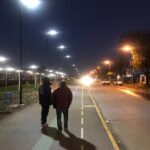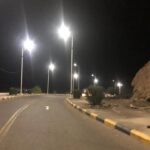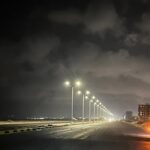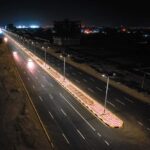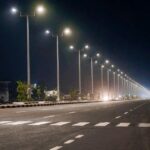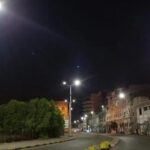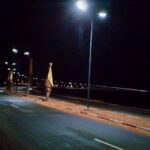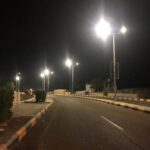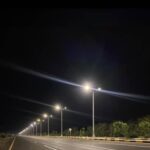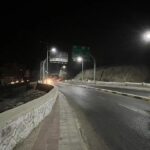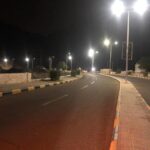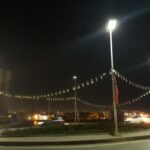The solar highway lighting system has many different applications, and one of them is to light up highways. Long-distance road users need to travel with excellent visibility when it gets dark. They also need to drive in comfort and safety knowing that all road signs and markings are visible to them.
A well-designed, energy-efficient solar highway lighting system should help the local authorities reduce reducing energy use and costs. The energy produced can be used to enhance the appearance of the settlements along the highway.
The use of a solar lighting system to illuminate highways can cut the cost of installation. It is possible to reduce the cost of installing the standard grid systems by 50 percent with solar technology. Energy-efficient technology is required where the energy from the mains is not enough to power an entire or part of the highway.
However, highways cut across different regions of varying characteristics. The amount of efficiency along the road will not be the same, as some places experience more sunlight than the rest. Also, safety can be a factor of consideration too. The above challenges could be the reason why most developing countries place these lighting systems in towns along the highways.
There are lighting standards for the solar high way lighting system. Here is some vital information that you can use in your upcoming project.
Lighting Requirements
When designing a solar highway lighting system, it is essential first to understand the light requirements of the road distance based on the traffic density of the road. This information will help you determine the installation specifications for your system. You can obtain this information from the existing Code of Practice for the lighting of public roads.
Matching Intensity with Traffic Trends
In most solar highway lighting systems, the intensity of the light source changes depending on the traffic on the road. You can quickly achieve this type of automation by using timers or motion sensor technology in the dimming systems.
By using a timer, the lighting system can adjust its illumination as time goes. The use of the timer method to control the levels of light is supported by research to determine the traffic behavior of the area that needs visibility.
The use of motion sensor technology relies on the level of activity below the unit to increase or decrease the intensity of light. When a car approaches, the solar unit will produce more light to make the road clear. The auto-intensity control requires the use of a Pulse-width modulation (PWM) technique and a programmable microcontroller to work.
Selection of Light Source
Most modern solar lighting systems use light-emitting diode (LED) and Compact Fluorescent Light (CFL) to light up the highway at night. The two types of lamps are known for producing brighter lights that increase the visibility of external objects, which would stay in the shadows when traditional or conventional lights are used.
It is a requirement that one should use a lighting fixture that has a low energy consumption or High energy savings, low maintenance, no mercury, and long-life span. Also, the selection of the lamp should have excellent color rendering properties and maintain illumination for an extended period. The luminous efficacy or the measure of lumens per watt also plays a vital role in this section.
Selection of Luminaire
The luminaire as a complete unit consists of the light source, power supplies, control mechanisms, optical elements (the reflector and refractor), the fixture, the housing, and other electronics. These are components and parts that help to support and position the bulb, connect the lamp to the power supply and distribute the light.
The optical elements are essential in controlling glare and light pollution. The Luminaires can be categories based on the Cutoff optical system (which aims to reduce the degree of glare). The available types include full-cutoff, cutoff, semi-cutoff, and non-cutoff Luminaires.
Therefore, it is critical to comply with the glare requirement limiting the intensity of light of the region you wish to install Luminaire. In some areas, the glare zone is limited to between 80° and 90°.
Type of Switch
Auto-switching is a cost-effective method for turning on and off the solar lighting system without any human intervention. You can achieve this technique by using light detector devices such as LDRs (light dependent resistors), photoresistors, Photodiode and PIR (passive infrared) detectors in the control mechanisms.
Pole Type, Height, And Spacing
The standards of street lighting also specify the material used for the pole, the dimensional size, and the distribution pattern. The type of pole material you use should factor in the weight, resistance to wind and life span of the pole.
Adhering to the standard pole spacing pattern and the recommended mounting height of the luminaires should provide the required light for the highway.
The Lighting standard for solar highway lighting systems requires:
- Proper pole height and spacing – meet uniform light distribution and levels for safety and security needs
- Proper luminaire aesthetics – blends well with the surrounding environment
- High lamp efficacy and luminaire efficiency – Minimizes energy consumption and cost and prolong the life span of the light source.
- High lumen maintenance – reduces the replacement cost of the Luminaires.
- Excellent color rendering – improve visibility and security by providing close to natural lighting properties.
- The proper cutoff – provides adequate optical control and minimizes light glare and pollution
- Automatic switching – reduce wastage of energy and reduce the cost of maintenance costs
Solar Highway Lighting System: Conclusion
The lighting standards for the solar highway light system aim to meet the local lighting requirements while at the same time attempting to achieve maximum energy efficiency. The system must be appropriate for the site and should provide the level of illumination and uniformity of light as specified by the street light codes of the region.
Some standards may vary from one country to another, but international communities control most of them. Abiding by the rules of lighting is the way to go to ensure safety and the conservation of nature using green technology.






